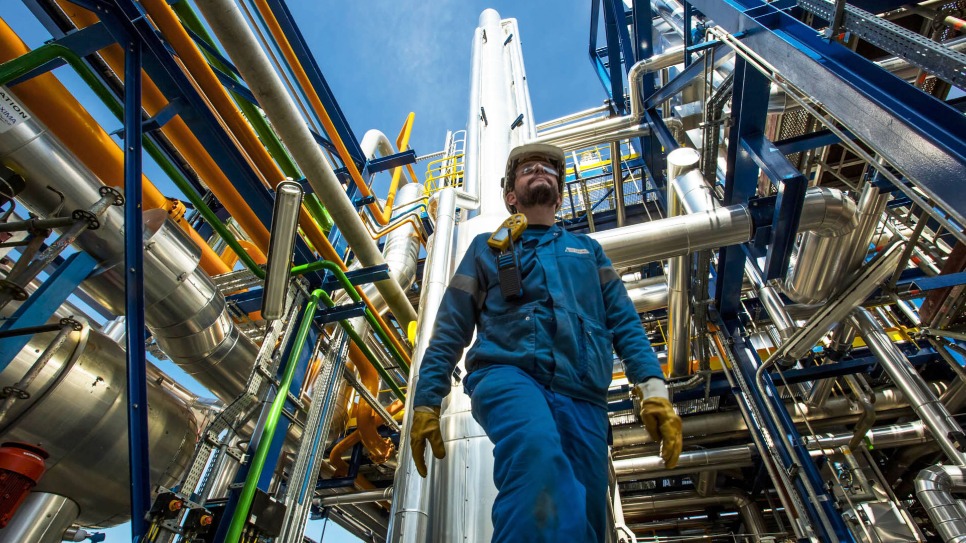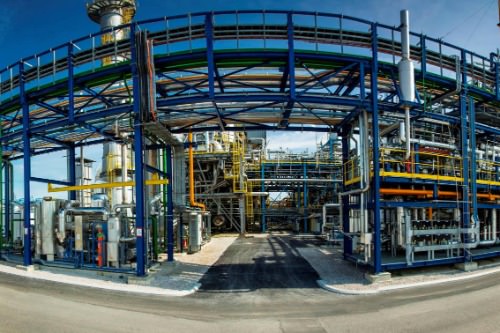Technical Article - October 21, 2021
Carbon Capture Utilisation and Storage: Delivering at Scale


Written by Fatiha Housni 5 min read
Carbon capture utilisation and storage (CCUS) has long been recognised as an important means of reducing carbon dioxide emissions and forms an integral part of the mechanisms needed to meet the Paris climate commitment goals. The IPCC and the IEA, for example, have argued that CCUS offers tangible results in decarbonisation, and can contribute to industrial competitiveness and new economic opportunities.
For many years, however, CCUS has been considered too expensive or insufficiently tested to be applied at scale. Concerns about the safety of transporting carbon dioxide, and about its safe long-term storage, have also contributed to the slow adoption of CCUS. While some large-scale industrial projects have successfully operated, the technology has not been widely deployed at a significant scale.
New urgency, new opportunities
This picture, however, is now changing. The need for urgent action to reduce carbon emissions has increased recognition that a portfolio of technologies are needed to tackle climate change: in many jurisdictions, CCUS is now considered a necessity, rather than an option, especially in sectors where emissions are hard to abate (such as cement, steel, and chemicals). These hard-to-abate sectors can leverage CCUS now to accelerate their emissions reductions, as opposed to sectors where process changes that cut emissions can be made more easily. The rising cost of carbon has improved the breakeven point for storage solutions. Many more CCUS projects are now planned or underway across Europe, North America and other regions of the world.
An integral part of our approach
Our CCUS technologies – grouped together under the name of ‘Cryocap™’ – represent one of several carbon management solutions we offer to customers. They are an integral part of the Air Liquide group strategy to decarbonise, both in our own operations and in supporting our clients’ energy transition. We are now actively working to capture CO2 emissions from our own plants, with 3 in-house projects in northern Europe (Porthos CCS project in Rotterdam, Antwerp@C and our partnership with TotalEnergies to develop low-carbon hydrogen production in the Normandy industrial basin, while also supporting our customers on their journey towards lower carbon. At Air Liquide, we are targeting carbon neutrality by 2050, with important intermediary milestones in 2025 and 2035:
to start reducing absolute CO2 emissions around 2025.
to reduce our scope one and two CO2 emissions by one-third by 2035 when compared to 2020.
The CCUS process
The key steps in CCUS involve the capture of CO2 emissions, which can be captured from a wide range of industrial processes such as metallurgy, cement manufacture, ammonia and hydrogen production, fermentation, hydrocarbon combustion and refining, and others. The recovery of CO2 and its subsequent purification and liquefaction is dependent on factors such as the costs of electricity and steam, the inlet CO2 stream characteristics, and the expected CO2 output conditions.
Once captured and purified, CO2 can be sequestered in geological formations such as depleted oil fields, coal seams, or deep-sea aquifers, or can mineralise in basaltic underground rock formations. It can also be used in gaseous or liquid forms: it can be recycled for a wide range of usages including the production of refrigeration systems, welding systems, water treatment processes, fire extinguishers, and carbonated beverages. It can also be used to produce synthetic fuels - including sustainable aviation fuels.
Air Liquide’s Cryocap™ technologies
Our Cryocap™ range of technologies build on our long-standing experience in CO2 management, from capture, purification, liquefaction, to storage and transport. We also have experience of upgrading the recovered CO2 and providing it to a range of markets including the agri-food industry, water treatment, chemicals, and others – in liquid, solid or gaseous form.
Cryocap™ technologies draw on our industry-leading experience in cryogenics – in which gases are separated at low sub ambient temperatures. The technology can be adapted to specific applications in combination with other Air Liquide technologies including absorption through solvents, the use of membranes, and pressure swing adsorption (PSA). Cryocap™FG, for example, captures CO2 from flue gases using a unique solvent-free technology based on the combination of adsorption and cryogenics. It is particularly well-suited for where flue gases have CO2 content of greater than 15%, in processes such as cement production, and is also suitable for steam methane reforming and fluid catalytic cracking (FCC). The PSA-assisted process can generate gaseous or liquid CO2 from flue gases in one step, with a capture rate of 85 to 95%. Cryocap XLL™ enables large-scale CO2 liquefaction, of approximately 700 to 7,000 tons per day. Flexible and compact designs enable plants to be customised to the appropriate size, with very low OPEX and very high rates of CO2 recovery.
Overall, Cryocap™ technologies minimise the total carbon footprint. In addition to its intrinsically higher efficiency when compared to solvent-based technologies, emissions are minimised by using electricity rather than thermal heat generation (which typically results in increased carbon dioxide emissions from the production of steam). Where the electricity generated is from renewable sources, the avoided emissions are even greater. Cryocap™ maximises avoided CO2 by reducing indirect CO2 emissions and delivers high CO2 rates of recovery of up to 95%.
The technology elements are highly efficient, and feature the integration of capture and liquefaction processes, which traditionally are separate. They offer compact solutions and flexible configurations, providing a simpler infrastructure than steam-based solutions where liquid CO2 is needed for transport by rail or ship. In some applications, adding Cryocap™ technology can improve the efficiency of the original process and enable enhanced production.
The technology is also safe, with no toxic or flammable substances used. In addition, Air Liquide’s wealth of experience in the safe handling of gases includes the management of carbon dioxide. All Cryocap™ products deliver either high-pressure gaseous or liquid CO2 at marginal extra cost and can meet the most stringent CO2 specifications. The process can also deliver reductions in other process pollutants, such as NOx emissions.
Scaling up
At Air Liquide, we have progressed from running pilot and demonstration CCUS plants to initiatives of greater scale and ambition. Building on experience from our Port Jérôme facility in Normandy, where captured CO2 is used as a supply for agri-food markets, we have been engaged on a number of industrial scale CCUS projects, over more than a decade. This experience has enabled us not only to capture and manage much larger volumes of CO2, but to develop technology variants that treat a range of off-streams including flue gases with high CO2 concentrations – of 15 to 30% – and from steam methane reformers (SMRs).
The Zeeland Refinery Azur project
We have recently signed a contract with the Zeeland refinery in the Netherlands, a joint venture between TotalEnergies (55%) and Lukoil (45%). The project provides for a carbon capture and liquefaction solution, enabling the capture of more than 90% of the emissions from the refinery’s SMR hydrogen production units. The initiative will lead to the avoidance of approximately 800,000 tons of emitted CO2 per year from the Vlissingen site. It is planned to be operational in late 2025.
"At Air Liquide, we are committed to making a difference to the abatement of CO2 emissions at production facilities and for our customers. We are pleased to support the Zeeland refinery project with our innovative carbon capture technologies that will contribute to the site's decarbonisation" – David Maloney, Group Vice President, Engineering & Construction and Capital Implementation, Air Liquide.
“The step CO2 emission reduction by applying carbon capture and storage. By integrating this innovative technology into the existing refinery scheme, Zeeland refinery will strengthen its position in the low carbon future that lies ahead of us.” – Natalie De Muynck, General Manager of the Zeeland refinery.
Air Liquide is providing the licence and process design package as part of the agreement. The project forms an important part of the Zeeland refinery decarbonisation project, to produce clean hydrogen. After capture, the pure liquefied carbon dioxide will be transported by ship to Total’s platforms in the Dutch North Sea.

Written by Fatiha Housni on October 21, 2021




